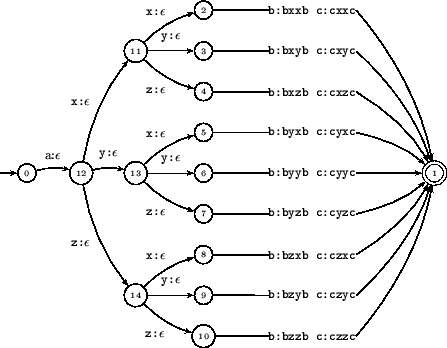![\begin{pspicture}(-1,-1.5)(10,1.5)
\psset{unit=0.02cm}\rput(0,0){\circlenode[]{0...
...\mbox{\sc b}\langle
?\rangle\langle ?\rangle\mbox{\sc b}$}}
\par\end{pspicture}](img144.gif)
![\begin{pspicture}(-1,-1.5)(10,1.5)
\psset{unit=0.02cm}\rput(0,0){\circlenode[]{0...
...\mbox{\sc b}\langle
?\rangle\langle ?\rangle\mbox{\sc b}$}}
\par\end{pspicture}](img144.gif)
 |
Suppose we were to expand this example into
a classical subsequential transducer, then depending on the size of
the alphabet, the resulting transducers would have many more states.
The example for the alphabet
![]() with 15 states and 31
transitions is given in figure 1; for an alphabet of 26
symbols, the result already has 705 states and 2055 transitions. For
an alphabet of 254 symbols, the result has 64773 states and 193803
transitions. Instead of having two question marks on the input side in
a row, consider similar examples where we have k such question marks
in a row:
with 15 states and 31
transitions is given in figure 1; for an alphabet of 26
symbols, the result already has 705 states and 2055 transitions. For
an alphabet of 254 symbols, the result has 64773 states and 193803
transitions. Instead of having two question marks on the input side in
a row, consider similar examples where we have k such question marks
in a row:
![\begin{pspicture}(-0.5,-1.5)(10,1.5)
\psset{unit=0.02cm}\rput(0,0){\circlenode[]...
...c b}\langle ?\rangle^1\dots\langle ?\rangle^k\mbox{\sc b}$}}
\par\end{pspicture}](img176.gif)
In these cases, the minimal qpfst will have 3+k
states. The equivalent minimal subsequential
transducer will require
![]() states. An analysis of the difference in succintness in
terms of descriptional complexity (e.g. [7]) is beyond the scope of this article;
but this class of examples suggests that there are arbitrarily many
relations for which the qpfst device requires exponentially fewer
states than subsequential transducers.
states. An analysis of the difference in succintness in
terms of descriptional complexity (e.g. [7]) is beyond the scope of this article;
but this class of examples suggests that there are arbitrarily many
relations for which the qpfst device requires exponentially fewer
states than subsequential transducers.